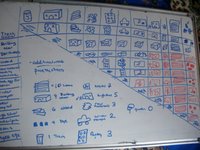Monday, October 23, 2006

Another entry from
More Haiku:
The Turkish Toilet
“Not bad when you’re used to it.”
“I’m not used to it...”
“Masi, Muskil,”* I
Hear that phrase a lot these days
Oh, all those faux pas.
* It means “no problem”
Super PACA tools
Looking forward to using
With the artisans.
PACA stands for Participatory Analysis for Community Action -- having people tell you about their world as opposed to your just observing it. As an exercise in using the tools before using them with artisans, we split into four groups -- men; over-40 women; just-out-of-school 20-something women; and older 20-something women (there’s one 30-something). I’d been trying to figure out group dynamics -- some people hang out with others, but for the most part there aren’t really cliques -- people sit with different people at meals or take walks into town with whoever’s ready. Well, the group dynamics of the over-40 group was another story. Remember, people, brainstorming is non-judgmental and it’s important to give everyone a chance to speak -- and this is only an exercise! It was tough to be in this group -- a couple of strong personalities clashing, a couple who withdrew, and the rest of us in the middle.
PACA Tool #1 - community mapping. Draw a picture of what’s important to you (post office, cyber cafe, fruit store, candy store, for example) and then for each important site circle frequency. Use a different color for its importance of lack thereof, use +/- for like/dislike, and then list needs on the side. This was my favorite tool - it was fun to look at each group’s map and to see not only that different groups had different frequencies and importance but different things on the map entirely. Plus, since this group is half artist, there were some nice pictures.
The next tool is needs assessment/priority ranking. You list your needs, brainstorming as to what could make your life better. Then you put these in a matrix and pair them off one by one until you arrive at a ranking. In the exercise I kept voting for consistently hot showers and Godiva chocolates on our pillows. This one was fun too. Then you had to think about feasibility – timeframe, financial resources, human resources, sustainability, challenges. Could they implement the Godiva chocolates by next week? Maybe. Swimming pool? No. This really is an interesting way to think about things and I can see its use.
The next two tools weren’t as much fun for me as exercises, but it will be interesting to interview the artisans. One was daily activity schedule – in this culture (and to some extent in ours) the women’s schedule varies quite a bit from the men’s – they have to fit their work in among all their household responsibilities. It’s interesting to look at old reports and see how people spend their days, from waking up to going to bed. And then there’s seasonal calendar – the lives of the artisans differ quite a bit according to weather, employment (do they also have to plant or harvest, for example), income (do they sell more in summer) and expenditures (summer vacation/wedding season and Ramadan are often more expensive – but sometimes more comes in then, too).
The artisan sector in